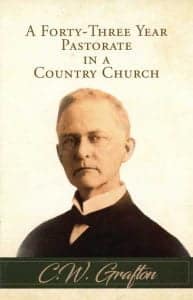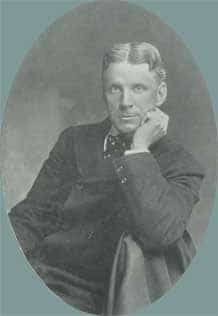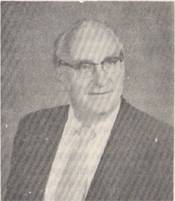
“Tell me about them big arms!”
Cornelius Washington Grafton was born on December 21, 1846 and died on this day, August 1st, in 1934. Trained for the ministry at Columbia Theological Seminary, Rev. Grafton was for forty-three years the pastor of the Union Church Presbyterian Church in rural Mississippi. Most of our resources on this memorable pastor are not at hand, and so we will glance over further details of his life, but the transcript of a little booklet he wrote on his years of ministry is available and it presents some interesting insights into rural ministry before the advent of the automobile. In the following portion of that booklet, Rev. Grafton gives an overview of his work as a pastor in a rural setting:—
PASTORAL WORK AT UNION CHURCH FOR FORTY-THREE YEARS.
The pastoral work has been very laborious. Including Bensalem, the sister church, our congregation stretches over twenty miles in legnth and about the same in breadth, 400 square miles. Around the church the people are more thickly settled, and they can always come to church and Sunday School. And a good deal of the pastoral work can be done by walking around from house to house. But in the outlying sections of the congregation this has been impossible. Some of our members rarely ever get to church and they cannot have the benefit of the Sunday School and the prayer service. And when the preacher goes to see them, it’s a long, hard day’s work; if the roads happen to be bad, especially hard. Some of the trips the country preacher has taken, make one tired to think about. Three fine horses and two or three buggies have been worn out in the service and I am now looking around for the horse that will probably last till sunset comes.
(Since the above was written for the General Assembly, the school boys and girls of the Union Church High School, of which I was principal for ten years, as will be explained further on, united and bought for their teacher, a Ford touring car. At out summer communion occasion this year, a bright young lawyer from a neighboring town, one of our former schoolboys, made a touching address to the congregation, presenting the car as an expression of their tender regard.)
A visit to quite a number of our families cannot be made oftener than once a year, but a pastoral visit in the country means more than it does in the cities and towns. In the big cities, I suppose, the preacher spends his mornings in the study and walks out in the afternoon and calls on his flock and goes to see four or five and sometimes just leaves a card. But not so in the country. You send word beforehand that you are coming such and such a day, and when that day comes, rain or shine, you start early in the morning. You get to the house by and by and find them all looking for you, and they come out to the gate to meet you. Your horse is put away and fed; after a little while, if it is summer time, they cut the big melon or bring out the peaches and figs. By and by the bell rings in the dining room and lo, dinner is ready.
Solomon says, “Put a knife to thy throat when thou sittest at the table of kings.” He says again, “Better is a dinner of herbs where love is, than a stalled ox and hatred therewith.” But in these old country homes you have the ox and love too, besides the clean herbs of the field. If you ever felt like eating in all your life, now is your chance. But be sure you don’t eat too much. Many ridiculous stories we could tell of persons who forgot Solomon’s injunction. Two hours after dinner comes the ice cream, and again you minister to the outward man, for they have sent for this occasion out to the railroad for ice.
At last the Bible is brought out and now preacher, here again is your chance. You may not see some of these people again in twelve months. Give meat to parents, and pure milk of the Word for the little ones. Speak tenderly and earnestly and then in prayer remember all three generations that are here present, father and son and son’s sons and daughters. Sow seed for eternity.
The preacher naturally forms a line of habits. The first Saturday evening in January he goes to the Baker home, the first of February to the Buie home; Saturday before communion occasion to the Currie home, and so on and on throughout the year. Changes occur in the program of course, for death comes and homes are broken up. These long pastoral rides are formidable indeed. To wit: to ride 20 miles on horseback or in a buggy to see one of your people and back again the same day, twenty-five miles to see another family and back again the next day; and this is repeated again and again. Journeys of 15 miles a day are too numerous to mention.
One recompense though, is the pure air and the bright sunshine, and the beautiful woods and the flowing streams and the long trip with your boy or your girl. While laborious, some of these pastoral trips have been inexpressibly sweet and carry memories that can never die.
A missionary in distant China sits down in his home with his little boys and tells them of the long trips he used to take with his father in Mississippi, and how he talked of Bismarck and Napoleon and made the miles seem short as he drew pictures of the future. And the girl now grown to womanhood, can never forget the long rides to the railroad, the dinner by the roadside, the deep creeks and scary-looking bogs, the outpourings of girlish confidence and the warm-hearted friends met on the way.
Another recompense is in carrying the gospel personally to men. “Tell me about them big arms!” This was the language of a dying Scotchman as the pastor entered the room. The old man had heard the preacher talk sometime before about the God of Jeshurun, and underneath the everlasting arms, and like a babe in early childhood, he now felt the need of the strong arms.
Words to Live By:
Our Lord and Savior does indeed have big arms, and He is able to save to the uttermost all those who trust and cling to Him for salvation. This glorious truth is the same whether proclaimed in the city or the country. All men and women are at heart the same wherever they are. In all ages and times and settings, we are desperate sinners, dead to all that is holy and good and in need of One who will make us alive unto God, redeeming us from our sin and restoring us to eternal fellowship with the God who made us. So much attention is given to taking the Gospel to the cities. Pray the Lord would raise up those who would faithfully go to the towns, villages and countryside with the life-giving message of salvation in Jesus Christ our Lord.
The booklet, A Forty-Three Year Pastorate, by C.W. Grafton, is available from the Log College Press. Click here to view details



